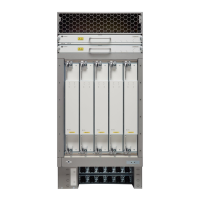Backup node in 0/RSP0/CPU0 is NSR-ready
Group Primary Backup Status
--------- --------- --------- ---------
dsc 0/RSP1/CPU0 0/RSP0/CPU0 Ready
dlrsc 0/RSP1/CPU0 0/RSP0/CPU0 Ready
central-services 0/RSP1/CPU0 0/RSP0/CPU0 Ready
v4- routing 0/RSP1/CPU0 0/RSP0/CPU0 Ready
netmgmt 0/RSP1/CPU0 0/RSP0/CPU0 Ready
mcast-routing 0/RSP1/CPU0 0/RSP0/CPU0 Ready
v6-routing 0/RSP1/CPU0 0/RSP0/CPU0
Step 8 From the active RSP, verify that both RSPs have synchronized the SNMP engine ID and SNMP ifindex-table
between each other:
Example:
#more disk0:snmp/ifindex-table loc 0/rsp0/cpu0
#more disk0:snmp/ifindex-table loc 0/rsp1/cpu0
#more disk0:snmp/snmp_persist loc 0/rsp0/cpu0
#more disk0:snmp/snmp_persist loc 0/rsp1/cpu0
Step 9 Manually copy Embedded Event Manager (EEM) scripts from RSP440 to RSP880 disks if applicable.
The EEM scripts are files located on RSP’s hard disk. These files are not automatically synced
between Active and Standby RSPs.
Note
Step 10 Perform redundancy switchover from active RSP440 (slot 1) to standby RSP880 in (slot 0)
Example:
Router# redundancy switchover
Step 11 Remove RSP440 from slot 1. Follow the procedure explained in the topic Removing and Replacing Cards
from the Chassis, on page 25.
Step 12 Insert and boot RSP880. After booting, the RSP 880 becomes standby RSP. Do not set the ROMMON variable.
Step 13 Repeat Step 7, Step 8 and Step 9.
Step 14 (Optional) Perform FPD upgrade on the RSP880. Use these commands:
Example:
Router# (admin) upgrade hw-module fpd all location 0/rsp0/cpu0
Router# (admin) upgrade hw-module fpd all location 0/rsp1/cpu0
Step 15 Clear ROMMON variable for active RSP from XR prompt:
Example:
Router# run nvram_rommonvar RSP_LINK_1G 0
Replacing Cisco ASR 9000 Series Router Components
35
Replacing Cisco ASR 9000 Series Router Components
Migrating from RSP440 to RSP880 or RSP880-LT Card

